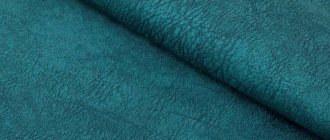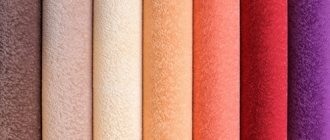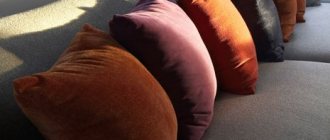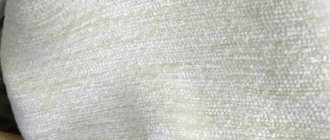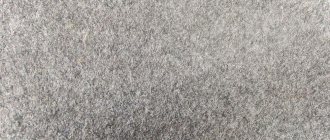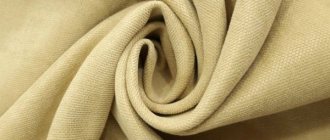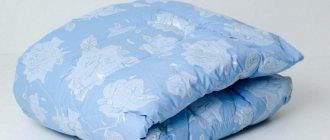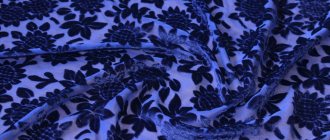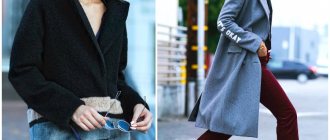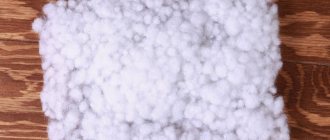Types of furniture fabrics
The main performance properties of materials used as furniture (upholstery) fabric are determined by its composition and manufacturing method. Manufacturers usually classify furniture fabric according to the method of application.
- Primary – upholstery. The fabric used for finishing the external elements of upholstered furniture has high aesthetic characteristics.
- Secondary – cover. Used as a technical coating for various structural elements of furniture: spring blocks, the inside or back of cushion covers, the back and bottom of armchairs and sofas. Budget materials are used as secondary fabric: thick burlap, cotton, chintz, calico, etc.
Durable and easy-to-care upholstery for upholstered furniture in cafes, will make cleaning easier and save money on reupholstery PHOTO: lechim-mebel.kiev.ua
By manufacturing method:
There are several methods for making furniture fabric:
- Woven is a traditional method of production by interlacing threads. For example, jacquard, tapestry, velor, boucle. The pattern on the surface of the upholstery is formed by weaving threads of different colors.
- Non-woven - there are several technologies, the principle of which is to apply various materials (fillers) with a large amount of polymer as a binder to the base. Tissue is formed under the influence of temperature, pressure, dehydration or polymerization reaction.
Furniture upholstery with woven and printed patterns differs significantly both in its aesthetic qualities and durability PHOTO: lineyka.com.ua
The pattern on the surface of the non-woven fabric is formed by printing in two ways.
- Dry – a finished pattern made of thermosetting paint, applied to a technical base (paper or special polymer), is transferred to the fabric under pressure or temperature.
- Wet - the image is applied to the surface through perforations in the walls of special ink drums.
According to the material of manufacture
Raw materials have a key impact on the technical, operational and decorative characteristics of upholstery fabric. Manufacturers usually distinguish between the following materials.
- Natural - environmentally friendly, hygienic, have good breathability and low intensity of exposure as allergens. However, natural materials have mediocre durability, are prone to shrinkage and wrinkle quite a lot. In addition, they are relatively expensive and difficult to care for. The raw materials used are wool, linen or cotton.
- Artificial - obtained by chemical processing of natural materials, for example, cellulose. They have an affordable price, vapor permeability, and a wide selection of colors and textures. They are extremely short-lived and quickly lose their presentation.
- Synthetic - polymer-based materials: nylon, acrylic, nylon, lavsan or polyester. They are characterized by a high degree of wear resistance and resistance to mechanical stress. Synthetic materials are easy to clean, even using household detergents. However, they can accumulate static electricity.
Many modern synthetic upholstery materials can hardly be distinguished from natural ones. On the left is synthetic, on the right is natural suede PHOTO: sambara.com.ua
Important! Artificial and synthetic materials can also cause allergic reactions.
Requirements for upholstery materials
Furniture fabrics are constantly exposed, so the main valuable consumer characteristics are:
- Durability, abrasion resistance.
- Peel resistance.
- Reliability of staining is measured on a scale from 1 to 8 points. The higher the number of points, the higher the color fastness.
- Fire safety. Minimum requirements: the fabric should not ignite when a cigarette is applied for 8-10 seconds.
- Environmentally friendly: it should not emit harmful substances.
- Chemical resistance.
- Low hygroscopicity and dirt absorption.
Fabric for upholstery - types and main characteristics
There are a huge variety of upholstery fabrics already in use. In addition, manufacturers are constantly developing new materials that combine high resistance to external influences with wide design possibilities: color, texture, pattern, etc.
When communicating with furniture makers, you may encounter the following classification of upholstery fabrics:
- pile (chenille, faux suede);
- non-pile (satin, tapestry, jacquard, boucle);
- non-woven (natural and artificial leather, flock).
Boucle
Relatively new upholstery material. The raw material is polyester thread, from which small loops are drawn along the entire length using special machines. Such fibers are used to make both plain and patterned fabrics, to which knots and irregularities in the structure give visual volume. Bouclé is characterized by high density and strength combined with softness and breathability. This upholstery is a wrinkle-resistant fabric and looks very good on voluminous upholstered furniture.
In boucle design, geometric patterns and stripes are most often used PHOTO: tkac.ru
Chenille
It began to appear en masse in the early nineties. The manufacturing technology is not fundamentally different from weaving lint-free fabrics. But in this case special fleecy threads are used. It was they who gave the name to this material. Chenille means caterpillar in French. Chenille has a wide variety of thicknesses, densities and hairiness, which depend on the raw materials used and the twist of the threads. For example, adding acrylic to the composition will give the upholstery additional softness, elasticity and eliminate wrinkles. Viscose will make the surface velvety and the color will be iridescent. Chenille fabrics are not subject to peeling and can be easily cleaned of dust with a regular vacuum cleaner. More serious stains can be removed using household chemicals intended for textiles.
Chenille has a rich color palette, collections are usually monochromatic PHOTO: kakieshtory.ru
Mat
It is a special variety of chenille. The structure and method of weaving resembles burlap with a slight hairiness on the front surface. Cotton or linen threads with a small amount of acrylic or polyester are used as raw materials for the base. Characterized by high strength and wear resistance. In most cases, the material is hypoallergenic, unpretentious and easy to care for. Used for furniture in Mediterranean, Scandinavian and country style. Recommended for children's interior items.
Matting imitates the rough texture of burlap, can be monochromatic or multi-colored, suitable for upholstering furniture in country style PHOTO: loveshtory.com
Velours
Velor upholstery fabrics are produced using the knitting method. The technology consists in the simultaneous production of two base panels, between which the pile threads are intertwined, secured in a V or W-shape. Then a special machine cuts the weaving threads, which are actually the pile. The second, W-shaped, weave option provides increased pile density and significantly improves the quality and durability of the fabric, but it is more expensive.
Velor combines high aesthetics, affordable cost and relatively high strength characteristics PHOTO: geliopolis.com.ua
Painting of the material is carried out after its production, in rolls. This provides a wide color palette, but slightly reduces fade resistance, and fabrics dyed in rich colors fade. Some brands of velor upholstery can stretch under heavy use. This material is recommended for private household use.
Velveteen
Refers to velor upholstery fabrics. It consists of an interlacing of five threads, one of which forms a pile. The texture is made of longitudinal strips of pile, separated by scars. The quality of the material, as well as its division into types - corduroy and micro-corduroy, is determined by the length of the pile and the width of the hem.
Corduroy is soft and velvety to the touch. It forms an anti-slip surface. It is recommended to use for upholstery of sofas used as a sleeping place. Bed linen will not slide on such a surface. The fabric has high wear resistance and strength.
Furniture corduroy is a completely synthetic or combined fabric with a large percentage of polyester in its composition, characterized by high mechanical resistance PHOTO: zlatamebel.ua
Corduroy upholstery is available only in plain versions, without patterns. However, this is compensated by a wide range of colors and shades. Some manufacturers' coatings, which contain synthetic materials, can accumulate electrostatics. In addition, corduroy is quite difficult to care for and requires special products to clean stains.
Flock
Refers to a type of non-woven textile. The production technology consists of gluing short pile onto a textile base. Modern manufacturers use various materials for the base, front covering and ultra-resistant adhesives. Under the influence of an electrostatic field, the fibers fall strictly vertically onto the adhesive layer. At the next stage, a multi-color pattern is applied to the flock coating using screen printing or embossing. Flock with embossed patterns is usually plain.
Front and back side of flock upholstery PHOTO: elegancetex.com.ua
When caring for flock fabrics, avoid the use of alcohol-based cleaning products, as it can dissolve the glue.
Jacquard
Lint-free fabric with a smooth or textured texture. It retains the original pattern well, which is obtained by weaving fibers of different colors on a special machine. The manufacturing material used is threads made from natural raw materials, cotton or linen in combination with synthetic materials.
Patterned jacquard, the pattern is formed by weaving PHOTO: elegancetex.com.ua
Over time, many improvements to jacquard manufacturing technology have been developed:
- thermal transfer of the pattern to the base is called thermojacquard;
- the use of fleecy threads along with smooth ones gave rise to a new material - jacquard chenille.
The fabric is quite expensive. However, its price is fully compensated by its durability and resistance to mechanical stress and fading.
Plain micro-jacquard with embossing PHOTO: obiv4ik.ru
Tapestry
The upholstery is close to jacquard in terms of manufacturing technology and performance characteristics. It has a clearly defined, albeit less relief, pattern. Made from thicker threads. Typically, more than 10 colors are used. Furniture tapestry is one of the most expensive materials. It is used in premium products.
A traditional pattern for a tapestry is a repeating floral pattern PHOTO: elegancetex.com.ua
Faux suede
Thanks to the use of modern technologies, artificial suede not only completely imitates natural material in tactile sensation and visually, but also significantly surpasses it in performance characteristics. It is characterized by high strength and wear resistance, resisting even significant mechanical stress without any damage to appearance. Resistant to ultraviolet radiation. Has an affordable price.
It has an expensive appearance, but requires careful care PHOTO: poztelio.com
However, it has a number of disadvantages. The main thing is low susceptibility to moisture, which has caused difficulty in cleaning. Grease stains, stains from fruit juices and sweet substances are almost impossible to remove on your own without damaging the surface. Therefore, despite its presentable appearance, artificial suede is not recommended for use as upholstery in areas of intensive use.
Faux leather
The base material is a knitted fabric made of synthetic threads coated with special examples. Many modern manufacturers offer consumers artificial leather that is practically indistinguishable from natural leather. This material is characterized by good durability, resistance to deformation and abrasion. One of the biggest disadvantages of artificial leather is its low resistance to mechanical damage. It is easy to scratch, and from systematic exposure to high temperatures it can crack.
Artificial leather is produced using a variety of technologies, from cheap dermantine to expensive coatings that cannot be distinguished from natural leather PHOTO: obbivka.com.ua
Alcantara
Alcantara was developed in the 70s of the last century. It is a synthetic analogue of suede. The manufacturing material used is polyurethane and polyester substances in the fibers. The production process is quite complex and includes many stages: spinning, impregnation, dressing, perforating, painting and some others.
Thanks to its high performance characteristics, Alcantara is widely used in many industrial areas. It is used to make decor and is used as interior decoration for yachts and car showrooms. Alcantara furniture upholstery is characterized by high durability, resistance to abrasion and mechanical damage. It is vapor permeable and UV resistant.
Alcantara was originally developed for the automotive industry, and is currently used in the production of luxury furniture PHOTO: taxpolice.spb.ru
Genuine Leather
It is one of the best materials for upholstery. Used in premium and elite class furniture. Characterized by high aesthetic and performance indicators. The thickness varies between 0.8-1.9 mm. It has a wide palette of colors, mostly monochromatic. The most expensive and high-quality products may have embossing. High-quality leather coverings are characterized by softness, wear resistance, strength, and the paint on the surface does not crack or crumble.
Genuine leather, used as furniture upholstery, is superior in its technical and aesthetic parameters to most synthetic and natural materials, but requires more careful, specific care PHOTO: legko.com
Leather is a natural material with a capillary-porous structure. Substances (natural or synthetic fats) located inside the pores give the coating the necessary elasticity. During use, they gradually dry out or erode. Therefore, to prevent cracking of the face layer, natural leather is periodically lubricated or sprayed with a special stearic lubricant.
The decorative properties of genuine leather are not limited to painting; embossing and relief formation are no less effective means of artistic finishing PHOTO: belmebru.ru
Reliable manufacturers
The leading positions in the global market of luxury textiles for furniture are occupied by:
- USA products - flock with unique abrasion Microfibres;
- classic and ethno-motives Ralph Lauren;
- acrylic fabrics for Sunbrella garden furniture.
Products from Italy, Belgium and Germany are also popular. Upholstery fabrics made in factories in Turkey, the CIS countries and Asia are not inferior in quality, but their cost is much lower.
Among Russian manufacturers of textiles for upholstered furniture, we can highlight TD "Veliga", which produces polyester fabrics for home and office use, and "Uzor" - multi-color chenille and jacquard fabrics, series for streets and office furniture. Also popular is the Tverskoy Polyester brand, which produces durable materials based on textured polyester threads.
Sunbrella
Factory "Uzor"
"Tver Polyester"
"Veliga"
Ralph Lauren
Microfibres
The conditional TOP 5 verified suppliers include:
- (Oktyabrsky settlement, Moscow region), since 2003, selling over 560 types of furniture fabric from the world's leading manufacturers. The MBL brand sells about 80 collections of velor (top sellers are Tatron, Sound, Sola, Savoy, Pony), suede (Sakura, Rest, Cork, Flint&Map), high-quality matting (Jez, Trinity, Mistik, Jude, Linen), eco-leather ( Aura, Bizon, Crocolale) and printed jacquard.
- Belorusskaya (Minsk) has been selling unique collections from Russian, European and Asian manufacturers, along with textiles of its own making, for 20 years. In particular, the factory specializes in the production of jacquard and chenille (16 main lines, including thermally printed fabrics) with abrasion resistance of up to 30,000 cycles.
- Arben Tekstil LLC (Shchelkovo) is a Russian distributor selling products from Aydin Tekstil, Carina, Microfibres, Escolys and Sertex. “Arben” took a leading position in the fabric market thanks to its rich assortment; over 170 collections of furniture textiles with a wide variety of colors and textures are sold under this brand. At least 50 of them are lines of fabrics with digital printing on different substrates.
- "Ramp" (Kharkov) is a fast-growing Ukrainian company offering consumers the best Belgian, Italian and German textiles with special protection against stains, bacteria, dust mites and unpleasant odors. Of particular interest are their collections of “smart” water-repellent fabrics Smart, high-density matting and microfiber Basic Line, and the premium Wisdom series.
- Manufacturing company Pavlin (Voronezh), selling the best fabrics for furniture from Russian, European, Chinese factories, including collections of digital printing of its own design (coupons on micro-suede or JE TAIME matting, colorful footage on Sacura matting).
It is not difficult to check the reliability of the supplier. Conscientious companies confirm the quality of their products with expert opinions and certificates. They also indicate a complete list of performance characteristics and warn about possible fabric flaws.
Pavlin
"Ramp"
"Arben Textile"
"Furniture fabrics"
"Furniture line"
How to choose fabric for upholstery
Furniture upholstery requires careful selection based on a combination of aesthetic and operational parameters. There are a number of characteristics, after analyzing which you can choose the optimal material for upholstery of upholstered furniture.
- Strength and wear resistance. These two parameters are interrelated and are responsible for the resistance of the material to external mechanical influences. For furniture used in residential premises, the recommended upholstery category is from 0 to 2. If the coating is subject to heavy use (offices, various commercial and public organizations), it is better to use materials of categories from 3 to 5. Naturally, these recommendations do not apply to premium category coatings 6 and 7, which themselves have fairly high reliability and durability.
- Color stability. The ability of the material to resist ultraviolet exposure (fading), as well as the influence of various chemicals and soapy water used in cleaning.
- Breathability. A key parameter if the furniture is used in damp rooms or a coastal climate.
- Fire resistance. Furniture upholstery used in cafes and restaurants must have a high degree of fire resistance and be self-extinguishing.
- Pillability. A parameter characterizing the obstacle to the formation of pellets during long-term operation.
- Anti-vandalism. The fabric must have a strong, non-deformable base; it is recommended for use in apartments where there are small children or pets.
- Easy to care for. Many modern materials require special care products; without them, they quickly lose their original appearance.
A mistake in choosing furniture upholstery can lead to quite sad consequences PHOTO: mosprima.ru
Oddly enough, design is not included in the list of key parameters. Modern manufacturers provide such a wide selection of colors and textures that even from one type of fabric you can choose upholstery for almost any interior style.
Fabrics with special properties
The name “Anti-claw” is known to any pet owner, because the upholstery, which does not have special protection, can be torn in a matter of days, along with the lining. The situation is saved by anti-vandal fabric for furniture, which does not form puffs when in contact with sharp claws due to the lack of thread weaving in the top layer, increased pile density or super-dense weaving of the base. Multilayer varieties of flock or velor, suede fabric impregnated with Teflon, microfiber based on polyester or polyamide, and smooth scotchguard have similar properties.
When choosing anti-vandal furniture textiles, pay attention in advance to its cleaning method. Despite their increased water-repellent properties, some fabrics with adhesive layers should be protected from direct contact with hot water. Despite all its effectiveness, such protection is not considered a panacea, because animals instinctively look for a place where they can sharpen their claws.
Velours
Smooth Scotchguard
Suede fabric with Teflon impregnation
Microfiber
Flock
General rules for upholstery care
Any furniture upholstery is initially designed to withstand repeated cleaning. Periodic cleaning using various cleaning products is the key to long-term use and a neat appearance of upholstered furniture. There are several generally accepted rules for keeping furniture upholstery in proper condition:
- regular vacuuming using a special attachment;
- special attention is paid to cleaning seams, places near buttons or areas hidden during the transformation of the mechanism;
- The stiffness of the brush must be selected depending on the type of material. The lower the category, the softer the bristles should be;
- Moisture-permeable upholstery should not be wetted. If wet cleaning is necessary, they are treated with heavily whipped soap foam;
- When wet cleaning artificial leather, genuine leather or waterproof upholstery, you must carefully study the manufacturer's recommendations. Many materials require special care products.
Special products for the care of natural leather make cleaning furniture much easier PHOTO: wildberries.ru
Criterias of choice
In addition to the main performance characteristics (wear and color fastness, peelability, composition), many other factors are taken into account when choosing fabrics for furniture, including:
- compliance with expected loads;
- color, texture, textile design and its compatibility with other interior items;
- comfort of using the fabric and its safety for human health;
- price;
- reliability of the manufacturer brand.
Visual and tactile inspection are mandatory: high-quality furniture fabric has a uniform color, a dense structure without pilling, and does not leave lint particles in the hands when crumpled.
If you are in doubt about the quality of fabric for furniture, you can order a small fragment for independent or laboratory testing.
Purpose
Depending on the functional purpose, all furniture fabrics are divided into secondary (also known as cover or cover fabrics) and primary (upholstery) fabrics. The first group is represented by inexpensive natural compounds hidden between furniture elements or used to make interior covers. The second category includes all upholstery fabrics (both smooth and fleecy) with high levels of decorativeness and wear resistance.
| Task | Recommended fabric type, possible limitations |
| Closing springs or soft filling, upholstering hidden parts of upholstered furniture | Available secondary (also known as covering) fabrics based on cotton, linen or jute fibers: calico, satin, calico, canvas, burlap |
| External upholstery of sofas and armchairs, upholstered headboards | Any primary upholstery material with high wear resistance (from 20,000 cycles) |
| Removable cover or blanket for the sofa | Velor, flock, chenille, microfiber, fleece, faux fur |
| Covers for frameless furniture | Thin, breathable, elastic fabrics for internal covers (ideally membrane impregnated with waterproof pads), high-quality artificial suede, eco-leather, polyester, oxford for external ones |
| Chair upholstery | Tapestry, jacquard - for chairs in living rooms, eco-leather, synthetics with Teflon impregnation - for kitchen furniture |
Additionally, attention is paid to the type of upholstered element. For example, it is not advisable to cover moving areas with fleecy types, but for soft headboards the fabrics should be pleasant to the touch.
Sofa cover
Upholstery of upholstered furniture
Covers for frameless furniture
Headboard upholstery
Chair upholstery
terms of Use
When choosing fabrics, taking into account the expected operating conditions and the location of the furniture, you should focus on the recommendations collected.
| Task | Operating conditions, requirements | Recommended types |
| Decorating furniture in the living room | Frequent use, direct exposure, high demands on upholstery cleanliness | Velor, jacquard, tapestry, leather if necessary to create a rich interior, universal flock |
| Sofa upholstery for bedrooms | High requirements for environmental cleanliness and breathability | Fabrics based on synthetic and natural fibers, jacquard or chenille |
| Upholstery of children's furniture | Frequent contamination, mechanical stress, jumping | Flock or chenille impregnated with stain-repellent compounds, scotchgard or print for teenagers' rooms |
| Kitchen furniture protection | Contact with oily substances, fire risks, need for private wet cleaning, unpleasant odors | Teflon-impregnated fabrics, eco-leather |
| Upholstery of office or commercial furniture | Highly susceptible to wear and tear, risks of loss of aesthetics after 2–3 years | Flock, artificial leather, synthetic fabrics with abrasion resistance of at least 30,000 cycles (with heavy traffic - from 45,000), chenille or leather - for rooms where smoking |
| Outdoor use (terrace, cafe) | Intense mechanical and atmospheric influences | Dralon, Teflon-impregnated acrylic, specialized fabrics for outdoor furniture |
Rules for cleaning leather furniture at home, review of products
Additionally, attention is paid to the proximity of radiators or fireplaces (synthetics do not tolerate them well), the presence or absence of animals in the house (checking anti-vandal properties is mandatory), the likelihood of absorbing unpleasant odors and the expected degree of wear. In apartments with children, where the risk of damage to furniture upholstery increases, the use of fleecy fabrics or those that require only dry cleaning is not advisable.
If you need to wash all types of furniture fabrics frequently, microfiber is the most reasonable solution.
Kitchen
Terrace
Office
Bedroom
Children's
Living room
Room design
The emphasis is on the combination of color, texture and style of fabric, both with other interior items and with the selected model of upholstered furniture. General rules include:
- A ban on the use of richly patterned textiles for upholstery of upholstered furniture with an abundance of stitching or complex cut.
- Combination of fabric pattern with the design of the table or shelves. The simpler the lines of cabinet furniture, the lighter the design should be, and vice versa.
- Consider the brightness and direction of lighting - stamps that wear out quickly or are dark look unsightly in bright light.
When arranging an interior in styles such as classic, baroque or empire, preference is given to leather, corduroy or velor upholstery, jacquard furniture fabrics, and tapestry. Faux suede looks good in loft spaces. Plain flock, chenille, velor furniture fabrics or other brands with a shimmer effect are ideal for lovers of modernism. Fans of innovative ideas should pay attention to fleecy upholstery materials with rich solid colors, jacquard with geometric patterns, imitation watercolor painting on furniture coupons and abstract prints. Microfiber, smooth eco-leather, chenille, flock furniture fabrics, including brightly colored ones, are the optimal solution for modern designs (high-tech, futurism).
Empire style
Country
Classic
Loft
Modern
High tech
Price range
Depending on the cost of the material, fabrics are distinguished:
- Economy class, withstanding no more than 7,000–15,000 abrasion cycles. This group includes budget types of jacquard or tapestry, lightweight brands of chenille, artificial suede, flock or corduroy with a service life of 5 to 7 years.
- Medium class (20,000–35,000 cycles) with a service life of up to 10 years. Standard quality is jacquard, tapestry, dense types of chenille, flock or eco-leather. This group includes furniture coatings with anti-vandal properties and a very interesting design.
- High and premium class (45,000–75,000 or over 100,000 cycles, respectively), imitating natural materials or having a unique design.
When purchasing furniture textiles, you should not go for cheapness: economy-class fabrics pay for themselves only if the upholstery is changed frequently. The material of the middle and high segment, on the contrary, pays off in the long term.
Economy class
Middle class
Premium
Conclusions and recommendations
Based on the many years of experience of many furniture makers, we can give the following recommendations for choosing upholstery material for furniture for various purposes:
- for household use: cotton, flock, scotchgard, thermo-jacquard, corduroy, velor;
- for offices, cafes and other places where furniture is subject to intensive use: jacquard, microfiber, artificial leather, boucle, chenille;
- if the issue of cost is not relevant, for executive and luxury class furniture it is best to use tapestry, Alcantara and genuine leather.
Happy shopping! If you want the author, be sure to fill out the feedback field!
Rating of upholstery fabrics
What fabric is better to choose a sofa from, sew upholstery and cover it? This question will be answered by reviews from real owners, as well as a rating of the best fabrics for upholstered furniture, compiled by independent experts.
According to many, the best in the ranking looks like this: 1 Flock. 2 Chenille. 3 Jacquard. 4 Velor. 5 Tapestry. 6 Leather. 7 Artificial leather.
The basis for the rating was the characteristics of the fabrics, the optimal price and its relationship with quality.
So, if you need to choose new upholstered furniture or reupholster old ones, carefully choose the upholstery material. In this case, you need to take into account many different characteristics and your individual needs and financial capabilities.
© 2021 textiletrend.ru
Professional advice: which one to choose for the sofa?
When choosing upholstery fabric for a sofa, experts recommend considering the following general criteria:
- Is the fabric easy to clean from dirt?
- what is the resistance to moisture, sunlight, abrasion and other exposure factors;
- strength and service life;
- attractiveness and aesthetics;
- Do the colors and textures match the interior style?
The choice of sofa upholstery depends on the location:
- Kitchen . It is better to use artificial leather, as it does not require complex care and does not absorb foreign odors.
- Children's room. Inexpensive upholstery materials that are resistant to dirt are suitable: chenille, flock, artificial leather.
- Office. We need practical, abrasion-resistant materials that have a presentable appearance. It can be natural or artificial leather.
- Living room. The choice of upholstery fabrics for halls and halls is very diverse, depending on the style of the interior.
Attention . In smoking areas, you should choose materials that do not absorb odors, such as leather and chenille.
Extend the life of furniture with proper care
Contamination is often caused by accident - coffee was spilled, berry juice dripped, or the dog got in with dirty paws. After such troubles, you need to clean the entire sofa, or a small section of it. A few tips will make this process easier:
- Regular cleaning with a vacuum cleaner will prolong the fresh look;
- the upholstery should not be wetted too much, because it does not dry well;
- with strong brushing, some furniture fabrics pill and lose their appearance;
- You should especially pay attention to the seams and places where buttons are attached, because this is where the main dirt accumulates;
- A weak soap solution copes well with dirt;
- tea and coffee stains are removed with a vinegar solution;
- Stains are removed from the skin with a damp cloth.
A short video with tips on what upholstery to choose if you have a cat at home:
